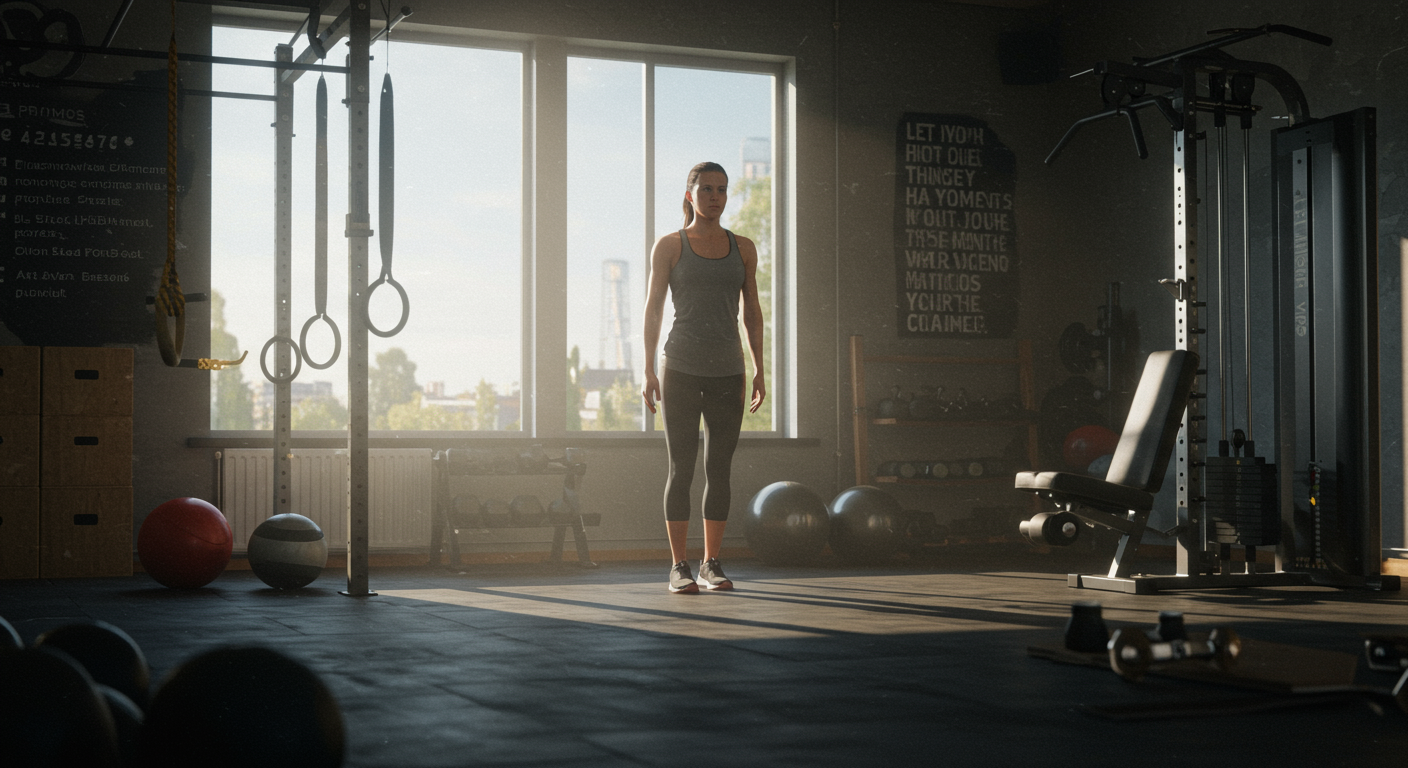From Spare Room to Sanctuary: Why This Home Gym Caught My Eye
So, I was scrolling through r/homegym the other day (as one does), and I came across this post titled, “My birthday, Christmas, Valentine’s Day, and Mother’s Day gift for the next 5 years 😅.” It was a picture of what the poster called “The Hangar” – a seriously impressive home gym setup. I’m talking serious dedication. But more than just the equipment, what really grabbed me was the thought behind it. This wasn’t just a haphazard collection of weights; it was a planned, personalized space.
The poster mentioned a few key things that really stood out. First, they had installed an ERV (energy recovery ventilator) for air circulation. That's a pro move right there, showing they were thinking about long-term comfort and air quality, not just throwing up some weights in a musty basement. Second, they had overhead speakers hooked up to a Raspberry Pi, streaming music from their phone. That's smart integration of tech, turning a workout space into something that's actually enjoyable to be in.

It got me thinking: a home gym isn't just about having the right equipment. It's about creating an environment that makes you want to work out. It’s about making it a place you look forward to spending time in. So many people start with enthusiasm, buy a treadmill and some dumbbells, and then... nothing. The equipment gathers dust, becomes a clothes rack, and the fitness goals fade away. Why? Because the space itself isn't inspiring. It’s not theirs. This Reddit post, though, showed how to do it right. And that's what I want to break down.
Decoding "The Hangar": More Than Just Iron and Steel
Let's dissect what made “The Hangar” so compelling. It wasn't just the sheer amount of equipment (though that was impressive). It was the thoughtful planning that went into the space. The ERV for air circulation is a prime example. Think about it: how many home gyms are stuffy, poorly ventilated spaces? You're already working hard, breathing heavily, and then you're stuck in a room filled with stale air. Not exactly motivating. By investing in proper ventilation, the poster created a more comfortable, healthier environment.
Then there's the Raspberry Pi-powered sound system. Again, it's not just about blasting music. It's about creating an atmosphere that you enjoy. Music is a huge motivator for a lot of people. By integrating it seamlessly into the gym setup, the poster made it easier to get pumped up and stay focused. It's these little details that separate a truly great home gym from a mediocre one.
Beyond the specific equipment and tech, there's also the element of personalization. The poster called it "The Hangar." That's a statement. It's giving the space a name, an identity. It's making it their own. That sense of ownership is crucial for long-term motivation. You're not just working out in a spare room; you're training in your space, a place you've designed and customized to fit your needs and preferences.
What This Actually Means for Your Own Gym Dreams
Okay, so maybe you don't have the budget for an ERV or the technical skills to set up a Raspberry Pi-powered sound system. That's totally fine. The key takeaway from "The Hangar" isn't about replicating it exactly; it's about understanding the principles behind it. It’s about creating a space that works for you.
What does that look like in practice? First, think about the environment. Is the space well-lit? Is it well-ventilated? If not, what can you do to improve it? Even something as simple as adding a few plants can make a big difference. Next, consider the things that motivate you. Do you love listening to music? Invest in a good sound system (doesn't have to be fancy). Do you enjoy watching videos while you work out? Mount a TV or set up a tablet.
The point is to create a space that you actually want to be in. That might mean different things for different people. Maybe you're a minimalist and prefer a clean, uncluttered space. Maybe you're a maximalist and want to fill your gym with all sorts of gadgets and gizmos. There's no right or wrong answer. The important thing is to be intentional about it. Don't just throw some equipment in a room and hope for the best. Think about the details, the things that will make you feel good and keep you coming back for more.
The Brutal Truth: Home Gyms Aren't Always a Motivation Machine
Let's be real for a minute. Building a dream home gym is awesome, but it's not a magic bullet for fitness. There will be days when you just don't feel like working out, even if you have the most amazing setup in the world. That's just part of being human. The key is to anticipate those days and have a plan in place to deal with them. I've seen people spend thousands on equipment, only to have it sit unused after the initial excitement wears off.
One of the biggest challenges with a home gym is the lack of external accountability. When you go to a commercial gym, you're surrounded by other people who are working out. That can be a powerful motivator. You also have the structure of classes and the presence of trainers to keep you on track. At home, you're on your own. It's easy to make excuses, skip workouts, and let your fitness goals slide.
Another potential pitfall is the "shiny new toy" syndrome. You get all excited about your new equipment, work out like crazy for a few weeks, and then get bored. The novelty wears off, and you start looking for the next big thing. This is why it's so important to focus on building sustainable habits, not just chasing quick results. A home gym can be a great tool, but it's just a tool. It's up to you to use it effectively.
Making the Home Gym Work for Your Hectic Life
Okay, so how do you actually make a home gym work, especially when you're juggling work, family, and all the other demands of modern life? The key is to be realistic and flexible. Don't try to replicate a commercial gym experience at home. Instead, focus on creating a routine that fits your schedule and your lifestyle.
One of the biggest advantages of a home gym is the convenience. You don't have to drive to the gym, wait for equipment, or deal with crowds. You can work out whenever you have a spare 30 minutes. That means you can break up your workouts into smaller chunks throughout the day. Instead of trying to squeeze in a full hour-long session, do three 20-minute workouts. Or even just two 15-minute workouts. Every little bit helps.
Another tip is to make your workouts as enjoyable as possible. If you hate running on a treadmill, don't force yourself to do it. Find activities that you actually enjoy, whether it's dancing, yoga, or lifting weights. The more you enjoy your workouts, the more likely you are to stick with them. And don't be afraid to experiment. Try different types of exercises, different routines, and different workout times until you find what works best for you.

Actually Putting This Into Practice: Steps to Home Gym Success
Alright, let's get down to the nitty-gritty. Here's a step-by-step guide to creating a home gym that you'll actually use:
Step 1: Define Your Goals: What do you want to achieve with your home gym? Are you trying to lose weight, build muscle, improve your cardiovascular health, or just stay active? Your goals will determine the type of equipment you need and the type of workouts you'll do. Be specific and realistic.
Step 2: Assess Your Space: How much space do you have available for your home gym? Measure the area and consider the layout. Think about the height of the ceiling, the location of windows and doors, and the availability of electrical outlets.
Step 3: Set a Budget: How much money are you willing to spend on your home gym? Be realistic and prioritize the equipment that's most important to you. You don't have to buy everything at once. You can start with a few essential items and add more over time.
Step 4: Choose Your Equipment: Based on your goals, your space, and your budget, choose the equipment that's right for you. Consider buying used equipment to save money. Things like dumbbells, resistance bands, and a yoga mat are a great place to start. A good adjustable bench is invaluable.
Step 5: Create a Workout Plan: Develop a workout plan that fits your schedule and your fitness level. Start slowly and gradually increase the intensity and duration of your workouts. Be sure to include both cardiovascular exercise and strength training.
Step 6: Make It Enjoyable: Add elements that will make your home gym a place you want to be. This could be a sound system, a TV, posters, plants, or anything else that motivates you.
Step 7: Stay Consistent: The most important thing is to stick with it. Make exercise a regular part of your routine, even if it's just for a few minutes each day. Track your progress and celebrate your successes.
My Take on All This: It's About More Than Just the Weights
So, after geeking out over “The Hangar” and thinking about home gyms in general, here’s where I land. It's not just about having the best equipment or the most space. It's about creating an environment that supports your fitness goals and makes you actually want to work out. It's about personalization, consistency, and a healthy dose of self-awareness.
A home gym can be an amazing tool for achieving your fitness goals, but it's not a magic solution. It takes dedication, planning, and a willingness to adapt. But if you're willing to put in the effort, you can create a space that will help you stay fit, healthy, and motivated for years to come.
Maybe I’m overthinking it, but I truly believe that the environment we create for ourselves has a massive impact on our success. Whether it’s a home gym, a workspace, or just your living room, taking the time to personalize and optimize your surroundings can make a huge difference in your overall well-being. And that, to me, is what fitness is all about.